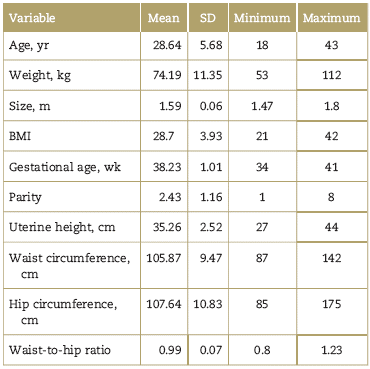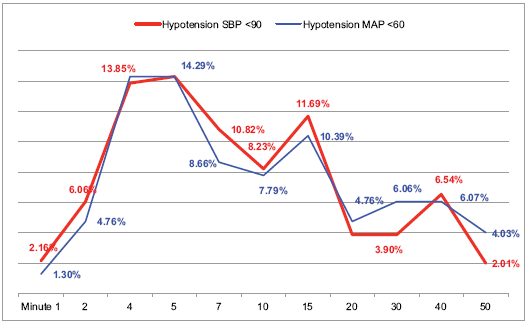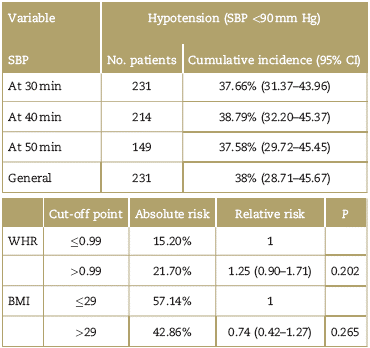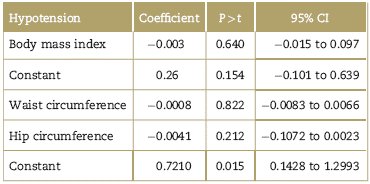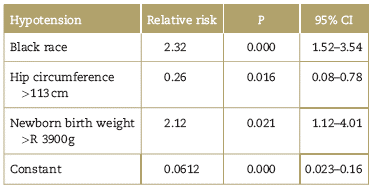Introduction
Hypotension in regional subarachnoid blocks has been defined as the most important and most deleterious side effect for the well-being of the mother and the fetus. Studies have focused on identifying the most relevant risk factors, including pathophysiology, early and effective prevention, and the creation of management protocols.
The definition of hypotension has varied among authors over the years, making it difficult to estimate its incidence. Studies have shown that reported incidences range between 1.9%1 and 71%.2 More recent studies came to greater agreement and proposed proportional reduction of systolic blood pressure (SBP) to a value lower than 70%-80% of baseline, or a reduction of the SBP value under 90 and 100 mm Hg.3-5 With the use of these definitions, the incidence of hypotension rose to 70%-80% of the pregnant women, despite fluid preloading or the use on nonpharmacological measures such as uterine displacement.4,6
Obesity and increased abdominal content because of the pregnant uterus are an additional risk factor for the occurrence of hypotension under regional anesthesia, as a result of a greater displacement of the intra-abdominal content, and vascular compression that aggravate the aorto-caval compression syndrome. This variable determined by waist-to-hip ratio (WHR) is an attractive predictor for hypotension that could be even better than body mass index (BMI). The objective was to determine if there is a positive correlation between anthropometric variables and the presence of hypotension in pregnant women taken to cesarean section under spinal anesthesia.
Materials and methods
This is a prospective analytical cohort study of 236 patients undergoing regional subarachnoid anesthetic block for cesarean section at Hospital Universitario de Santander and Clínica Materno Infantil San Luis, during the time period between July, 2014 and December, 2015. Patients over 18 with an ASA classification of 1, 2, and 3, taken to urgent or elective surgery, were included. Patients given epidural or spinal analgesia were excluded. The study was approved by the Scientific Research Ethics Committee of Universidad Industrial de Santander (Number 7083) and the Ethics Committee of Clínica Materno Infantil San Luis (Code DM-0076-14), and classified as minimum risk, because it did not propose any form of intervention. All patients signed an informed consent for anthropometric measurements.
A pilot test was conducted with 50 patients to determine sample size, and the incidence of hypotension in the group with WHR >0.99 was 19% versus 8%, with a 95% confidence interval (CI) and a 5% accuracy, for an estimated number of 236 patients.
Weight, height, and waist and hip circumference were measured initially. Basic monitoring was then initiated and vital signs were recorded (SBP, diastolic blood pressure and mean arterial pressure, heart rate, and pulse oximetry). The anesthetic procedure was then started according to the choice of the specialist, using a mix of local anesthetic with opioid (bupivacaine 0.5% 810 mg + fentanyl 15-20 mg + morphine 60-100 mg), and technique specifics were documented in the collection tool (position, puncture site, needle type, sensory level reached). Having verified the sensory level reached with the anesthetic block, the surgical procedure was then started and vital signs were recorded at predetermined intervals until the end of the procedure. The patients who developed hypotension were managed as judged by the anesthetist in charge, in accordance with the protocol of each institution. Management was documented in the tool, as was also the case with intraoperative signs and symptoms such as nausea, vomiting, and dyspnea. Data regarding the newborn were also recorded.
Population characteristics were described using means, ratios, and proportions with their respective CIs. The outcome variable was classified in accordance with the prior description, and it was used to estimate incidence, expressed in percentages.
Variables which, according to the literature, could behave as risk factors for hypotension were identified. A linear regression analysis was performed to assess the behavior of WHR and BMI as predictors of hypotension. This was followed by univariate and bivariate analyses to select the variables with sufficiently large statistical significance that would be included in the model. A P < 0.2 was selected, but only those variables with values <0.05 were considered significant. Finally, binomial logistic regression was used for modeling.
Results
Overall, data for 231 pregnant women were collected (98% of the calculated sample). Mean age was 28 years, and mean gestational age was 38.2 weeks. Mean WHR was 0.99. Table 1 shows the information regarding anthropometric measurements and other general characteristics of the patients and the procedure.
Of the pregnant women, 90% belonged to the white race, and 82.6% had no comorbidities, the most frequent pregnancy-associated disorder being hypertension (10%). The main indication for cesarean section was a previous history of this surgical procedure (61%), followed by fetal macrosomia (7.3%).
The anesthetic technique in the sitting position was the most frequent (64%), with the use of the No. 25 pencil-tip needle in 99.1% of cases. The most common access was the L3 to L4 space (86.5%), achieving sensory levels between T2 and T5, the most frequent being T4 (53.2%). Of the anesthetic mix used, 59.74% consisted of bupivacaine 8mg, fentanyl 20 mg, and morphine 80 mg. The average amount of intravenous fluids was 1668 mL, and blood loss was 565 mL. The lowest birth weight was 1655 g and the highest was 5690g.
All patients were followed through to the end of the surgical and anesthetic procedures. The time period between 4 and 7 minutes after anesthesia induction was the most hemodynamically labile.
Incidence of hypotension
The incidence of SBP <90mm Hg was 38.01% (P=0.000). The highest incidence of 13.85% and 14.29%, respectively, was recorded on minutes 4 and 5. There were 90 episodes of hypotension during the first 30 minutes; 18.18% of the women had at least 1 episode, and 3.8% had more than 3.3) A single vasopressor was used in 79% of the cases, and phenylephrine was the agent most frequently employed (see Fig. 1 and Table 2).
Anthropometric variables and arterial hypotension
The mean WHR was 0.99; 45.89% of the patients had a WHR ratio >0.99, and the incidence of hypotension in this group of patients was 21.7%, with a relative risk (RR) of 1.25 (95% CI 0.90-1.71), and no statistically significant difference (P = 0.2020). In patients with an above-average BMI (28.71), the incidence of hypotension was 42.86%, a lower and nonsignificant value (P = 0.265) when compared with patients with a lower BMI (see Table 2).
Correlation between arterial hypotension, and body mass index and waist-to-hip ratio
A linear assessment of WHR (as a continuous variable) did no show a significant regression value that could point to the probability of developing arterial hypotension. Moreover, the assessment of each variable of the WHR did not show a positive trend for predicting hypotension. The greater the diameter of the 2 variables, the lower the probability of developing hypotension. The value was plotted against BP at each time point, and there was never a linear correlation; on the contrary, there was great scatter with negative values as well. BMI behaved the same as WHR when assessed continuously in a linear regression. No predictable behavior was observed (Fig. 2 and Table 3).
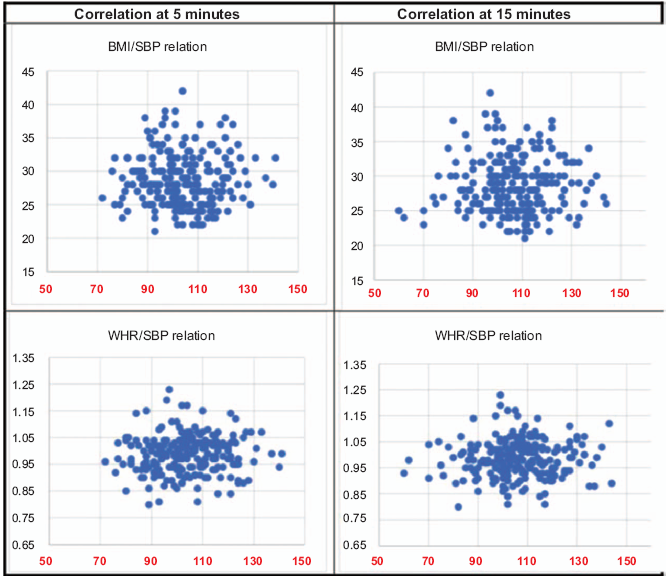
Source: Authors.
Figure 2 Correlation between systolic blood pressure, and waist-to-hip ratio and body mass index.
Bivariate model and arterial hypotension
The remaining variables were evaluated, either baseline or related to the anesthetic technique and intraoperative events. Variables related to sociodemographic characteristics did not behave as risk factors for hypotension, and those related to the anesthetic technique had the greatest influence on the development of hypotension. Variables with a P value <0.20 or for which clinical evidence has shown association were included in the model: birth weight percentile 90 (RR 1.8, 95% CI 0.9-3.5, P=0.108), age >29 years (RR 1.31, 95% CI 0.75-2.26, P = 0.33), bupivacaine >10mg (RR 1.01, 95% CI 0.48-2.11, P = 0.966), blockade above T4 (RR 1.14, 95% CI 0.65-1.97, P=0.637), among others.
Once the binomial regression model was applied, the only variables remaining in the final model (P < 0.05) were: black race, birth weight of the newborn (>R 3900 g), and hip circumference (greater than 113 cm). The model yielded an area under the ROC curve (AROC) of 0.6415 (Table 4).
Regarding the newborn, there were no adverse effects based on the APGAR score at 1 minute and at 10 minutes. Nausea was the most frequent adverse effect in terms of intraoperative symptoms (19.5%). The incidence of vomiting, yawning, and dyspnea was low.
Discussion
The research design and analyses confer validity to the outcomes. There are no studies in the literature reporting the relation between WHR and hypotension in pregnant women subjected to subarachnoid regional anesthesia. A limit value of 90 was selected for SBP, considering that it is the most frequently used in various studies, as recommended by Liu et al.5
Results showed a totally negative or inverse, although nonsignificant, trend: the greater the WHR, the lower the probability of developing hypotension. This is contrary to the pathophysiological mechanism leading to the development of hypotension where the mechanical effect of aorto-caval compression is added to reduced arteriolar tone due to sympathectomy.7 It would have been expected that the higher the WHR, the greater the visceral abdominal content, and, consequently, the greater the hypotension due to mechanical compression.
If aorto-caval compression by the pregnant uterus is a proven. The sole significant risk factor was fetal birth known factor for hypotension, this variable could be weight greater than 3900 g, a variable that was also selected as a surrogate predictor and estimated on the included in the final model. Although its value in the basis of the WHR. However, our hypothesis was not AROC was fair (0.645), it reinforces the idea that the estimated weight of the newborn is the variable with the highest weight as predictor of hypotension, and could help guide preventive interventions in the population with estimated fetal weights above this value. In any case, a higher fetal weight is expected to be associated with a higher WHR, but this relationship was not demonstrated on the basis of our results.
The weight of the newborn was identified as a risk factor for developing hypotension (RR 2.12, 95% CI 1.52-3.54, P = 0.021) when it is higher than 3900 g. This finding correlates with hypotension due to aorto-caval compression supported by multiple stud-ies.6,8,9 Black race was also associated with a higher relative risk (RR 2.32, 95% CI 1.52-3.54, P = 0.000). However, this is not supported in the literature, and further studies as required to propose it as a possible predictive factor.
A potential explanation for the findings may be that hypertensive disorders in pregnancy are more frequent in overweight and obese women.10-12 They develop endothelial alterations and dysfunction as a result of elevated plasma levels of leptin, insulin, and systemic mediators such as C-reactive protein, interleukin 6, and tubular necrosis factor alpha.13 All these factors predispose to hypertension and counteract the typical after-load reduction resulting from lower systemic vascular resistance during pregnancy.13,14 Moreover, studies conducted in the general population point to arterial hypertension and obesity as risk factors for hypotension associated with regional spinal anesthesia15,16;and although this is not comparable with the obstetric population, one could assume that they would behave similarly under the effects of anesthesia. This is yet another argument that reinforces the hypothesis of alternative pathophysiological mechanisms that prevent the development of hypotension in pregnant women under anesthesia.
Our study is not free from potential bias, and the unavailability of baseline data for the patients at the start of pregnancy (WHR and BMI) left us with weight gain and variations in WHR and BMI as variables that might play and important role. The ability to use these values in a cohort study might lead us to think that the differences could probably not be associated with the content of the abdominal cavity, but rather with the variationsofthese2variables, added to the weight of the newborn, despite the fact that some observations have not found a relationship between abdominal circumference and the risk of hypotension.17
Findings related to sensory level, anesthetic dose, and other variables, which, despite showing absolute risk of hypotension and being reported in multiple studies,6,8,9,18) were not included in the final model. This could be explained by the low doses of anesthetics used, under 10 mg of bupivacaine, supported in the literature as a means to reduce the incidence of hypotension and as a way to improve intraoperative comfort and postoperative pain when combined with an opioid, as compared with high dose bupivacaine with no opioid.19
Conclusions
Waist-to-hip ratio and BMI do not correlate with the risk of developing hypotension under regional subarachnoid block during cesarean section. On the contrary, fetal birth weight higher than 3900 g was shown to be a risk factor for the development of episodes of hypotension. Further studies are required to confirm this finding.
Ethical disclosures
Protection of human and animal subjects. The authors declare that the procedures followed were in accordance with the regulations of the relevant clinical research ethics committee and with those of the Code of Ethics of the World Medical Association (Declaration of Helsinki).
Confidentiality of data. The authors declare that they have followed the protocols of their work center on the publication of patient data.
Right to privacy and informed consent. The authors have obtained the written informed consent of the patients or subjects mentioned in the article. The corresponding author is in possession of this document.











 text in
text in 

